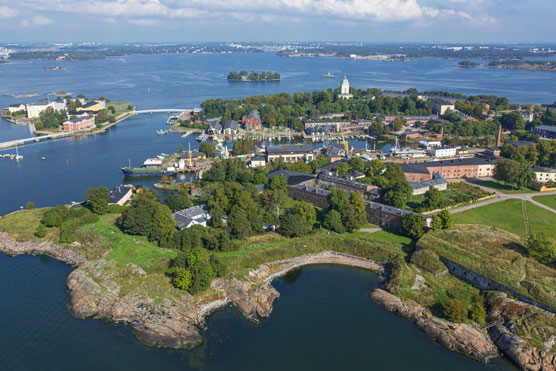Press release 2022-05-05 at 9:57

World heritage site Suomenlinna © The Governing Body of Suomenlinna
The Finnish Rotary and the Governing Body of Suomenlinna are taking part in the monitoring and research work being carried out by the Finnish Environment Institute SYKE on the quantities, types and sources of litter. The Rotary members are committed to counting and classifying all litter from Patterilahti, Susisaari in Suomenlinna, a UNESCO World Heritage Site near Helsinki.
The tracking of litter in Patterilahti is part of extensive national monitoring of beach litter. Currently, litter is monitored in Finland three times a year on 14 different types of seashore. During monitoring, all litter 2.5 cm in size and larger in the research area is counted and classified. SYKE is responsible for national beach litter monitoring, which is carried out by Pidä Saaristo Siistinä ry (the Keep the Archipelago Tidy Association) through citizen networks.
"The active participation of citizens plays an important part in the monitoring and research work on the sources, quantities and types of litter. The Finnish coastline is long, which is why residents are needed for both monitoring and cleaning up beaches. The Rotary members’ monitoring provides an opportunity to look into the types of litter that maritime currents carry near a large city and to gain a better understanding of the sources of litter. We do not have exact information about the overall situation of the environment becoming littered or the amount of litter in the sea produced by various human activities on an industry-by-industry basis,” says Senior Research Scientist Sanna Suikkanen from the Finnish Environment Institute.
The Rotary members are committed to a three-year monitoring of Patterilahti. Three clubs and about 20 members are involved, taking turns in monitoring. Monitoring will be carried out in spring, summer and autumn.
“The Rotary members also have an aim relating to communications in this project. As the Rotary is an international movement, we have many contacts with other countries. As a model of societal influence, the Suomenlinna project is an excellent example of what can be achieved through volunteer work. A large number of international exchange students visit Suomenlinna through us every year. Through them, we are disseminating information about the project to various parts of the world,” says Liisa Stjernberg, member of the Baltic Sea Committee from the Southern Finland Rotary District.
In Suomenlinna, volunteers participate in both the monitoring and cleaning of litter
Among other things, plastic pellets, shock tube detonators and polymer fibre, which was used as a support material for spray concrete on the surface of the West Metro tunnels in the early 2010s, have been found in Patterilahti, Susisaari in Suomenlinna. Fibre is still being found, even though the beach has been regularly cleaned for several years. Typically, cigarette ends, broken glass and plastic can also be found on the beach.
“According to our observations, maritime currents carry waste from mainland snow dumps, construction waste and other litter from boating and recreational use of beaches, especially to the western coasts of the Suomenlinna islands,” says landscape expert Iina Johansson from the Governing Body of Suomenlinna.
The Governing Body of Suomenlinna is a state agency under the Ministry of Education and Culture, which restores, maintains, presents and manages the UNESCO World Heritage Site of Suomenlinna. The Governing Body offers volunteers the opportunity to participate in the preservation of the World Heritage Site. Different ways are used to do this, including clean-up days of the beach areas and the activities of the park pal programme.
Littering is a broad problem
Marine litter has many potential sources, as it is generated in the production, transport, use and destruction of materials, both on land and at sea. The amount of marine litter produced by a particular industry is difficult to estimate, as it is often very difficult to determine the source, route and geographical origin of individual pieces of litter.
According to Suikkanen, the observations of the Governing Body of Suomenlinna support the view that the littering of beaches in the vicinity of large cities differs from the littering of other beaches.
“In addition to recreational use of beaches, boat and ship traffic and construction cause littering in the vicinity of Helsinki, as there are several large beach construction and land reclamation sites near beaches. At sea, littering is caused by fishing. In other monitoring beaches, the main cause of littering is the recreational use of beaches,” Suikkanen says.
According to the monitoring results, about 90 per cent of the beach litter in Finland consists of plastic, and up to 70 per cent of litter on urban beaches consists of cigarette ends. Other common types of litter are food packaging, foam rubber, bottle caps and lids, plastic bags and ropes, and unidentified plastic litter.
“Littering is one of the global problems threatening the marine environment. Information is needed to enable us to be more effective in identifying ways of controlling littering. The results of the beach litter monitoring are used, among other things, for assessing the state of the marine environment, monitoring the effectiveness of measures aimed at reducing littering, and identifying the sources of litter,” Suikkanen says.
Further information
Senior Research Scientist Sanna Suikkanen, Finnish Environment Institute SYKE, tel. +358 (0)29 525 1660, sanna.suikkanen@syke.fi
Liisa Stjernberg, Finnish Rotary, tel. +358 (0)50 525 8475, stjernberg.liisa@gmail.com
Landscape expert Iina Johansson, Governing Body of Suomenlinna, tel. +358 (0)29 533 8322, iina.johansson@suomenlinna.fi